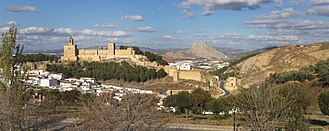This article needs additional citations for verification .(January 2021) |

The Alcazaba of Antequera is a Moorish fortress in Antequera, Spain. It was erected over Roman ruins in the 14th century to counter the Christian advance from the north.
Contents
The fortress is rectangular in shape, with two towers. Its keep (Spanish: Torre del homenaje, 15th century) is considered amongst the largest of al-Andalus, with the exception of the Comares Tower of the Alhambra. It is surmounted by a Catholic bell tower/chapel (Templete del Papabellotas) added in 1582.
Connected to the former by a line of walls is the Torre Blanca ("white tower").